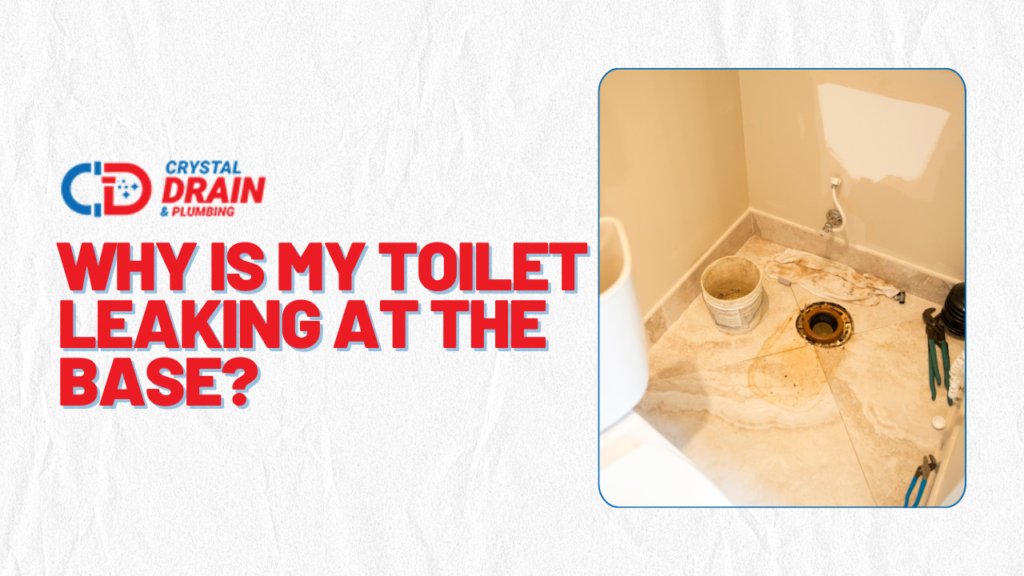- Last updated: December 11, 2024
Why Is My Toilet Leaking at the Base?

A leaking toilet base is more than a minor inconvenience—it can lead to serious hygiene concerns and costly structural damage to your bathroom floor and subfloor. Ignoring the problem can result in escalating water damage, mold growth, and an increasingly expensive repair bill.
At Crystal Drain & Plumbing, we pride ourselves on identifying and resolving plumbing issues efficiently and with precision. This guide will help you understand the common causes of a leaking toilet base, how to address them, and preventative measures to ensure long-term durability.
Key Takeaways
- Toilet base leaks can result from worn wax seals, loose bolts, cracked porcelain, condensation, or faulty supply lines.
- Early diagnosis and prompt action can prevent costly water damage and maintain the longevity of your bathroom fixtures.
- Professional plumbers, like those at Crystal Drain & Plumbing, can quickly identify and resolve complex or persistent leaks.
- Preventative measures, including regular inspections and upgrades to durable components, can save you time and money in the long run.

Common Causes of Toilet Base Leaks
1. Worn Wax Seal
The wax seal is an essential component of your toilet’s plumbing system, creating a watertight seal between the toilet base and the floor drain. Over time, the wax can deteriorate due to age, heavy use, or improper installation, causing leaks around the toilet’s base.
How It Happens:
- Natural degradation of wax over time.
- Shifting of the toilet due to uneven floors or improper securing.
- High bathroom humidity accelerating the breakdown of the wax.
Solution:
Replacing the wax seal is the primary fix. Modern alternatives like rubber gaskets are available, offering a more durable and flexible option for sealing the base.
2. Loose or Corroded Toilet Bolts
The bolts securing the toilet to the floor (closet bolts) can become loose or corroded over time, leading to instability and breaking the seal between the toilet and the floor.
How It Happens:
- Daily use causing slight movements.
- Improper installation with uneven torque on bolts.
- Rust and corrosion in older homes with high moisture exposure.
Solution:
Carefully tighten the bolts to secure the toilet. Be cautious to avoid overtightening, as this can crack the porcelain base. If bolts are corroded, replace them with new ones.
3. Cracked Porcelain or Base Damage
Porcelain cracks are less common but can occur due to accidents or stress from uneven flooring. Even minor cracks can compromise the toilet’s structural integrity, allowing water to escape.
How It Happens:
- Dropping heavy objects onto the toilet base.
- Stress from improper leveling during installation.
- Gradual wear in older toilets.
Solution:
Replace the entire toilet if the base is cracked. Repairing a cracked base is not a reliable option, as it compromises the overall strength of the fixture.
4. Condensation and Poor Ventilation
Sometimes, what appears to be a leak is actually condensation from the toilet tank dripping onto the floor. This can occur in bathrooms with high humidity levels or during rapid temperature changes.
How It Happens:
- Warm, humid air coming into contact with a cold toilet tank.
- Poor bathroom ventilation exacerbating moisture buildup.
Solution:
Install a drip tray under the toilet tank, improve bathroom ventilation with an exhaust fan, or insulate the tank to reduce condensation.
5. Faulty Supply Line Connections
A leak in the water supply line near the toilet’s base is often mistaken for a base leak. Worn connectors or loose fittings are common culprits.
How It Happens:
- Over time, connectors degrade or loosen due to water pressure fluctuations.
- Poor-quality installation or materials can exacerbate the issue.
Solution:
Inspect the supply line for wear and ensure the fittings are tight. If necessary, replace the supply line with a new one.

Preventative Measures for Toilet Base Leaks
- Regular Inspections: Periodically check for signs of wear, such as loose bolts, deteriorating wax seals, or supply line leaks.
- Upgrade to Durable Components: Consider replacing the traditional wax ring with a rubber gasket for better durability and flexibility.
- Ensure Proper Installation: When installing a new toilet, ensure it is properly leveled and bolts are secured evenly.
- Improve Ventilation: Keep bathroom humidity under control by using an exhaust fan or dehumidifier.
- Prompt Repairs: Address minor issues, such as condensation or slight movement, before they escalate into major problems.
FAQs
Place paper towels around the base and supply line. Use food coloring in the tank to see if the water originates from the toilet.
A wax ring can last 20–30 years, but if the toilet moves or leaks, it should be replaced immediately.
Simple issues like tightening bolts or replacing the wax ring can be DIY projects, but complex cases involving cracks or extensive damage require professional help.
Repair costs vary based on the cause, typically ranging from $50 for minor fixes to $300 or more for significant repairs or replacements.
Not necessarily, but excessive condensation indicates poor ventilation, which can lead to mold growth and water damage.
